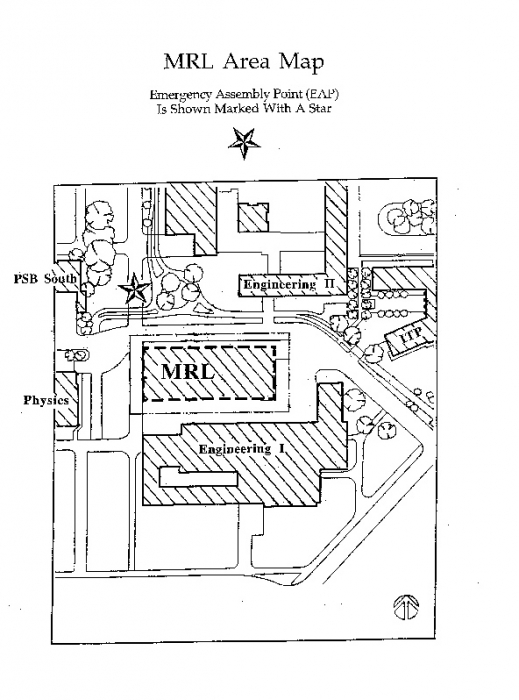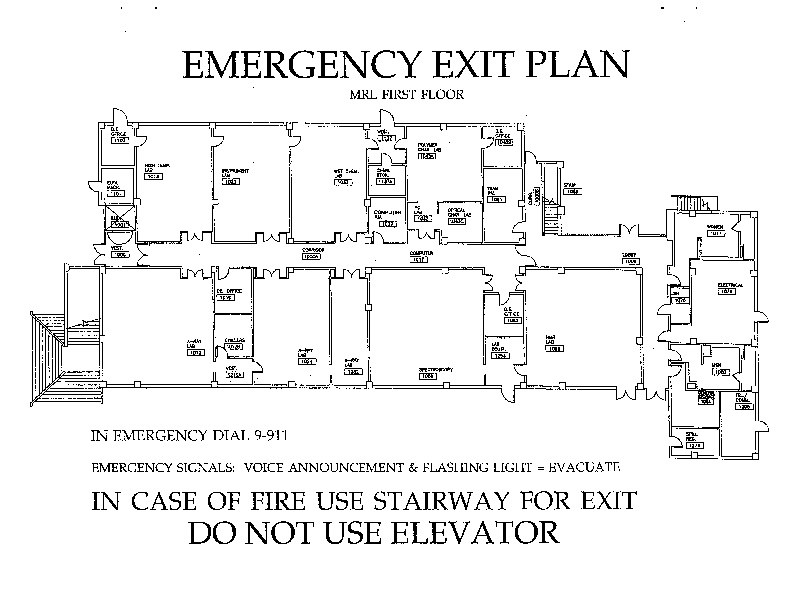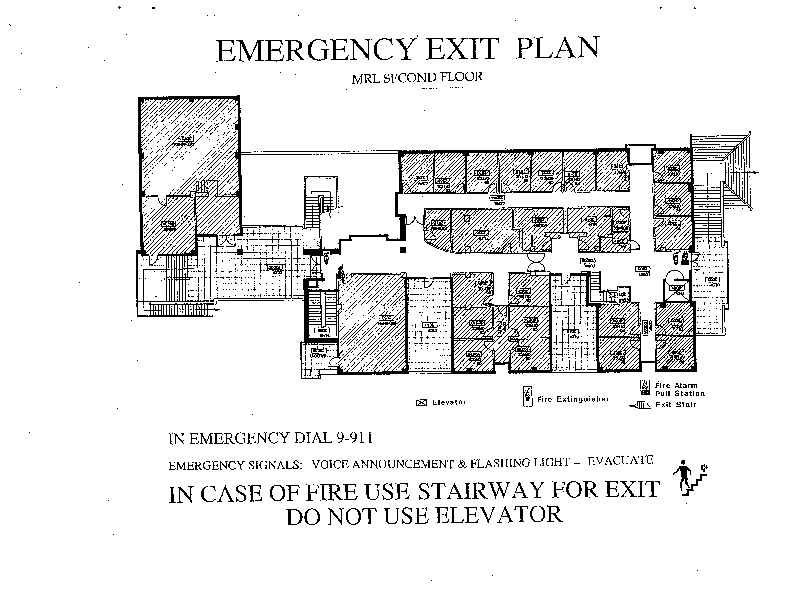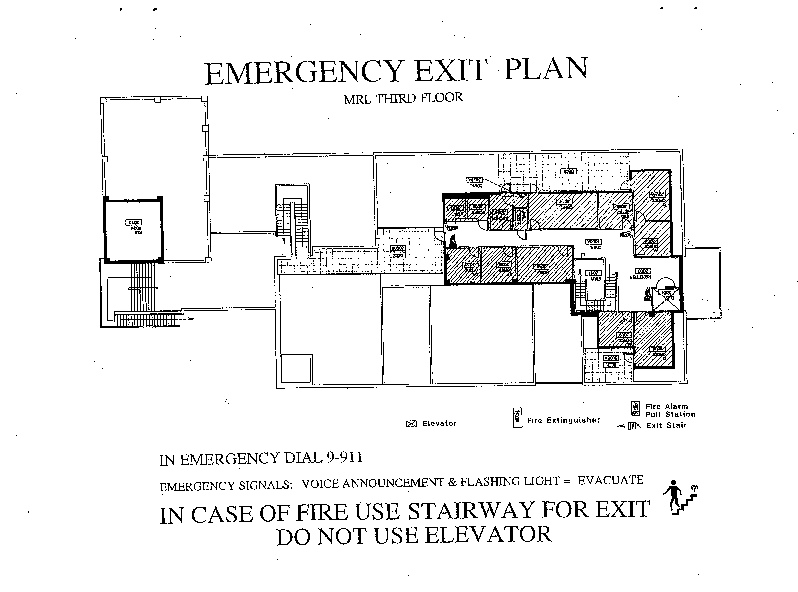Materials Research Laboratory
UCSB Building 615
Emergency Operations Plan
AKA Emergency Action Plan & Fire Prevention Plan
This plan is adopted by the MRL on June 17, 1998
Craig Hawker, Director
SUMMARY
In the event of a fire alarm or other emergency evacuation, all persons are to leave the MRL Building and to assemble on the sidewalk at the southwest corner of Engineering II. See area map for location. In the event of a major earthquake, all persons are to seek shelter in a door frame or other protected space. After the earthquake stops, and as soon as it is safe, all persons are to exit the building and to assemble on the sidewalk at the southwest corner of Engineering II. See area map.
MRL EMERGENCY PERSONNEL
Amanda Strom is the Hazard Communication Coordinator (HCC) for the MRL. She is also a member of the campus Emergency Response Team (ERT) and responsible for most utility and construction issues affecting the MRL Building. She can be reached at x7925 or by e-mail at amanda@mrl.ucsb.edu. His office is on the second floor in Room 2066F. Sara Bard is the Management Services Officer for the MRL as well as the Alternate HCC. She can be reached at x8519 or by e-mail at sara@mrl.ucsb.edu. Her office is located on the second floor in Room 2066E.
PREPARATIONS
The MRL shall maintain an Emergency Response Kit and it shall be stored in the 2nd floor kitchen (Rm 2042). This kit shall contain at least an AM-FM portable radio, a flashlight, extra batteries, and a first aid kit. First aid kits shall be kept in the 2nd floor kitchen (Rm 2042), 3rd floor kitchen (Rm 3026), TEMPO 1023, and vestibule between Polymer lab and TEMPO (Rm 1137). Chemical spill cleanup kits shall be kept in the vestibule between Polymer lab and TEMPO (Rm 1137), and 1278 (contact Amanda Strom for access). Laboratories, offices, and storage areas are to be kept in a safe fashion and in compliance with all environmental and safety regulations and good practice. All tall furniture is to be secured so that it will not fall over in an earthquake. All chemicals are to be stored in an appropriate and compatible manner. Chemical bottles are to be secured against falling during an earthquake. Researchers and other individuals are strongly encouraged to have copies of valuable and irreplaceable information stored away from campus, so that it is both safe and accessible if a building is temporarily or permanently closed. At least one member of the MRL technical staff should be a member of the campus Emergency Response Team (ERT). This person will receive training in hazardous materials, drill with the campus team, and may be called upon to assist the team in a campus emergency. An up to date home telephone list is to be maintained and distributed to key MRL personnel. All MRL personnel are expected to be familiar with their role as stated in this document.
INFORMATION SOURCES IN AN EMERGENCY
In many emergencies, the campus will send a message to every voice mailbox on campus with a report about the status of the campus and any expectations about whether employees are expected to come to work. The procedure to check one's voice mailbox from off campus is to call 893-8800, enter the last 4 digits of one's campus phone number when prompted for the mailbox number, press the * key, and then enter the 4 digit password when prompted. The following radio stations should have information about emergency conditions: KCSB 91.9 FM, KTMS 1250 AM, KUHL 1440 AM Santa Maria, and KVEN 1450 AM Ventura. KEYT Channel 3 and KCOY Channel 12 may have information on TV. The campus has set up an out of area telephone line for emergency information that is expected to survive a regional disaster. Calls are 55¢. The number is (900) 200-8272. Conditions of state highways are provided by Cal Trans at (800) 427-7623. If the Emergency Operations Center is operational, they may have a recorded message about campus status at 893-8690. See also Campus Emergency Information
EMERGENCY DURING WORKING HOURS
Emergency Affecting the Entire Campus
If there is an emergency that affects the entire campus, but the MRL seems relatively safe, such as an earthquake, brush fire, or flood, the first duty would be to determine the actual status of the MRL building. Is anyone injured? Were any chemicals released? Is there any obvious damage to the building? Are communications functional? If there is no compelling reason to leave, personnel should stay at work keeping out of other hazardous areas, staying out of gridlocked traffic, and staying out of the way of emergency workers. The HCC or Alternate should determine if the Emergency Operations Center (EOC) has been activated. If it has, the HCC should see to it that a Departmental Emergency Status Report is filled out and delivered to the EOC. It should be faxed to x8659, if possible. If fax is not possible, it should be carried to the EH&S Building, Bldg. 565, room 1045. This building is on the north side of campus between the Facilities Yard and the Rec-Cen on Mesa Road. The HCC should then check for any additional information and let the rest of the department know about the status of the campus and community. As a member of the ERT, the HCC may be called to work with the ERT during a campus emergency; if this happens, the Alternate HCC will assume all HCC duties at the MRL Building.
Evacuation of MRL Building
If it becomes necessary to evacuate the building or if any building alarm calls for evacuation, then every person should do so as quickly as possible. Even if the alarm is known to be a test or an exercise, all persons are required to exit the building. No one is assigned the duty of forcing anyone else to leave. If possible, people should bring their valuables and lock their doors behind them as they leave the building. All people leaving the building from the upper floors should use the stairs and not use the elevator. At this time, there are no disabled persons working in the MRL Building that would require assistance leaving the building. Should a disabled person begin working at the MRL, someone will be assigned to assist them in an emergency evacuation. After leaving the building, all people should assemble at the Emergency Assembly Point (EAP) which is on the sidewalk at the southwest corner of Engineering II, see area map for location. Should it be unsafe to assemble there, then people should assemble at the courtyard in front of (north of) the Geology Building. If possible, the Emergency Response Kit should be brought to the EAP by Jennifer Ybarra or, if she cannot, by Melissa Ruiz. No one is to re-enter the building until authorized to do so by County Fire or by UCSB Emergency Personnel. After a big earthquake or other severe incident, the building may be closed for several days or longer. At the EAP, each person working in each area of the building should gather with the other people from that area to determine if there is anyone missing. Building areas would include the third floor, the second floor, the team room, the TEMPO lab, the Polymers lab, the Spectroscopy lab, and the X-Ray lab. A personnel status report should be passed on to the HCC or the MSO as soon as possible. If the Fire Department or other Emergency Responders are called to the MRL Building, the HCC or MSO will meet them at the MRL Building Fire Alarm Panel Box as soon as possible after an alarm and will then inform them about the status of the building and especially its personnel. The Fire Alarm Panel Box is located on the first floor, just outside the building on the south side, near the door to room 1278. In a campus wide incident, the HCC will see to it that a Departmental Emergency Status Report is filled out and delivered to the EOC as described above in Emergency Affecting the Entire Campus.
EMERGENCY AFTER HOURS
In the event of an emergency when people are not at work, people should come to work at the usual time, provided it is reasonably safe to do so and provided that roads are passable. Each individual needs to take personal responsibility for their decision about whether it is possible to come to work or not. News about campus status, road conditions, etc. may be found through sources listed above under "INFORMATION SOURCES IN AN EMERGENCY". HCC and laboratory Development Engineers should attempt to come to the MRL to determine the status of the building and its laboratories.
EMERGENCY MANAGEMENT
Additional details about how to deal with the problems that follow are provided in the UCSB Laboratory Safety Program-Chemical Hygiene Plan black 3-ring binder in the section under Emergency Management. This binder should be available in every MRL laboratory and is accessible on-line at:
http://ehs.ucsb.edu
During an Earthquake
Do not rush outdoors. Most injuries occur from falling glass, plaster, bricks, debris, and electrical lines as people are leaving the building. Stay put during the initial shaking. Protect yourself. If possible sit or stand against a wall or doorway, or get under a fixed object (desk, table, etc.) Otherwise, cover your head and protect your body until the shaking stops. Stay away from all glass surfaces and windowed hallways (windows, mirrors, etc.) and cabinets and bookshelves. ABOVE ALL, REMAIN CALM. Think before you act and resist the urge to panic.
After an Earthquake
Remember aftershocks may occur at any moment with nearly the same force as the original quake -- so be prepared. After the initial shock, and only after the shaking stops, survey your area for damage and trapped persons. If severe building damage has occurred or if life-threatening conditions are observed, evacuate the building as described above and go to the EAP, on the sidewalk at the southwest corner of Engineering II. Do not use the elevators for evacuation. Once outside the building, move into the open areas. Do not stand under overhangs on the outside of a building. They are usually the most structurally unsound part of the building, and the first to collapse or fall. Move away from power lines, and stay away from all structures.
Discovery of a Fire
Upon initial discovery of a fire, alert personnel in the immediate vicinity. If possible, put the fire out by covering it or using a fire extinguisher. If there is time or it would be helpful, ask someone to get the HCC for assistance. After the fire is out, let the HCC know what happened as soon as possible. Anytime a fire extinguisher is used it must be recharged; call x3305 to have it recharged. If the fire cannot be put out, evacuate the area, close the doors to the room where the fire is located, and activate a Fire Alarm Pull Station or call 9-911 to report the fire. Once outside, let the HCC and MSO know what happened as soon as possible. Any fire in the MRL Building may contain hazardous materials along with any smoke. Stay upwind from any smoke or fire and avoid breathing any fumes. Any fire must be reported to the campus Fire Marshall. Usually the HCC will make this report.
Hazardous Chemical Release
If possible, a small and not too harmful chemical spill should be cleaned up immediately by the person who caused the spill. Appropriate personal protective equipment must be used. If there is any doubt about what to do, contact the HCC and/or the Development Engineer for that lab. Spill cleanup kits are available in Room 1023, 1033 and most other MRL wet labs. After the spill is cleaned up, let both the HCC and the lab Development Engineer know what occurred. In the event of a larger or more hazardous chemical release, evacuate the area immediately. Close off the room where the spill occurred. Contact the HCC or the lab Development Engineer immediately. For outside assistance, call the EH&S 24 hour hotline at x3194. For a very large or very hazardous spill call x3194 and contact the HCC IMMEDIATELY. Every chemical spill must be reported to EH&S within one day of the spill. Usually the HCC will make this report.
Utility Failure
Natural Gas Leak: If a strong smell of natural gas is detected, cease all operations; evacuate the area, and call the Campus Emergency Number, 9-911. DO NOT do anything that might cause a spark, such as turning a light switch or any electrical equipment on or off. Notify the HCC. Ventilation Problem: If odors come from the ventilation system, notify Facilities Management Dispatch at x2661, EH&S at x3194, and the HCC. If the odor seems as if it may be harmful, evacuate the area until it is investigated. If the odor suggests that a fire is in progress, activate the nearest Fire Alarm Pull Station or call 9-911. Other non-hazardous utility failures should be reported to FM at x2661 or to Amanda Strom.
Medical Emergency
People with serious medical problems need professional help immediately. In the worst cases, call 9-911 for paramedics or an ambulance. If the sick or injured person can travel: students may be taken to Student Health Services during working hours, x3371; and anyone may be taken to the Emergency Room at Goleta Valley Cottage Hospital at 351 S. Patterson Avenue, just south of Hollister Avenue in Goleta. Employees injured on the job may be covered by Worker's Compensation. Campus Business Services guidelines about how medical service is to be provided in such cases has been inconsistent. Information about current policy for non-emergency treatment can be obtained by calling Mari Tyrrell-Simpson in Business Services at x4169. Any employee injured while working at or for UCSB is responsible to report the injury to the HCC or MSO as soon as possible. The term "employee" includes graduate students and anyone getting any kind of paycheck. California law requires that the "Employee Claim for Worker's Compensation Benefits" be given to any injured employee within one working day from the time the injury was reported to the employer.
FULL EH&S MODEL EMERGENCY OPERATION PLAN AVAILABLE
The UCSB EH&S has written a model department EOP that contains a wealth of information and is very comprehensive. In the interest of brevity and with the expectation that MRL personnel will actually read it, this MRL EOP has been made as short as possible. Copies of the Model EOP are available at the MRL Safety Bulletin Board, from the HCC and from the MSO. In addition, it can be found on-line at:
http://ehs.ucsb.edu/



